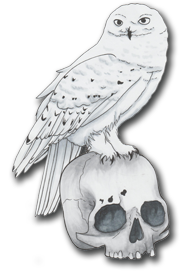Terminology
During the course of the research that I'm conducting, I've come across several different terms and expressions within original source text(s) that I've had to look up. As times change, so do spelling and translations, so I'm doing my best to assertain the meanings of the original text(s) in order to more accurately reproduce the original effects. Below are the terms that I've had to look up, along with the resources that I've used to draw my conclusions and/or assumptions.
"the berries of walworte"1
When I looked up "walworte", I found an entry2 specifying that it was an "herbe; Ebulus". This would lead me to find that the entry was referring to dwarf elderberry3.
"roche alome"1
Also found a more complete translation5 of "alum en roque, alun de roche" from Middle French, both thought to be referring to rock alum. This would appear to fit the parameters that I found the term utilized in, since the original translation was from French to English.
"lees"1
Contexturally, I believe this term to be used in place of "left overs". In reading through the available definitions of lees5, I did note an entry that indicated a reference to sediment in liquids, particularly from wine. In reading through the works of Pliny the Elder however, there is loose reference to lees and vinegar as if some instances utilize the terms interchangably.
"baye salt"1
I believe this to be a reference to sea salt. In looking up the definition of this particular adjusted spelling5, I do see references that would reinforce this idea.
"ruddle"1
I believe this is referring to the paint type mixture made with red ochre4. If this is the case, it looks as though it is based on hematite or iron oxide. Should the latter be the case, I would presume that this is referring to rust-based pigment.
"brasill"1
What I assume this to be referencing is brazilwood since it has a very dense oarangish red hue to it, but I will have to do some more looking around. I make this assumption after seeing shavings on the floor after seeing some turned on a lathe.
"Rubia Tinctorum"1
This refers to madder2, the roots can be dried and used to make a very deep red dye. From my understanding, the leaves might also be used, but the roots give the best tincture7.
Constructive feedback is both welcome and appreciated, please let me know if I missed some pertinent information or if there's somewhere I can improve.
As always, thanks for reading!
Ihone
- The secrets of the reverend Maister Alexis of Piemont by Girolamo Ruscelli.
OL 25228326M -
Translated from French into English by William Ward
There is a viewable pdf on Open Library
- Middle English Dictionary, Robert E Lewis, Editor-in-Chief. ISBN 0-472-01227-4
There is a viewable pdf on Google Books
- United States Department of Agriculture
Website contains a searchable database of plant names by species and common name.
- Wikipedia.org
Website contains a searchable database of many different topics. I try to find better sources that are first or second source material, but I sometimes reference this site in case all else fails.
- Dictionary.com
Website contains a searchable database of English words and terms. Was pleasantly surprised to discover that recent updates to the site also illustrate origins of the words in the database, along with a "difficulty index" to show how many people actually know what the words contained mean.
- Archaeologia, Or, Miscellaneous Tracts Relating to Antiquity, Volume 54, Issue 1 by Society of Antiquaries of London. ISBN-13: 978-1247344317
There is a viewable pdf on Google Books
- Plants for a Future (pfaf.org)
Website contains a searchable database of plants by common and genus name.
- Pliny's Natural History in Thirty-Seven Books Translated by Dr Philemon Holland
There is a viewable pdf on Open Library
